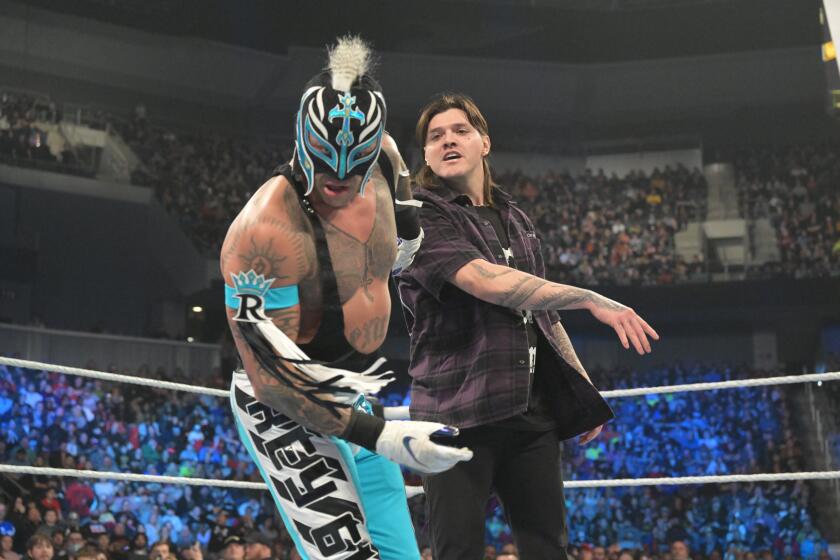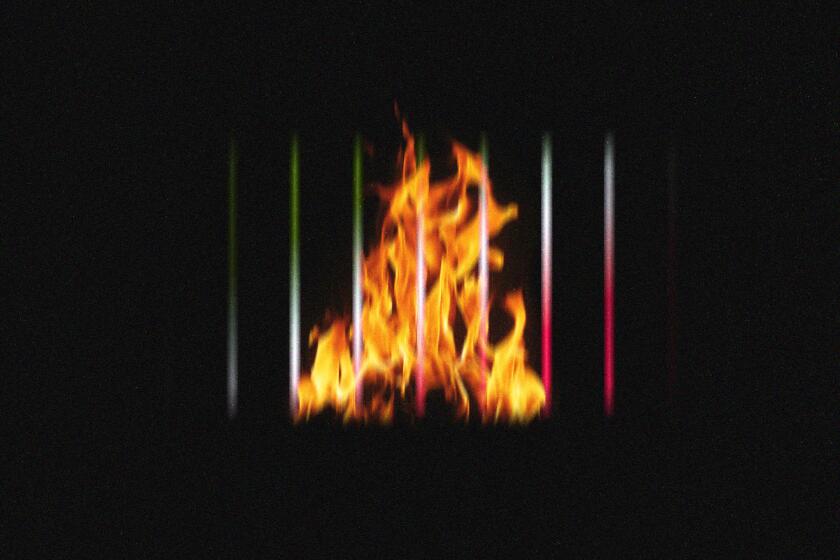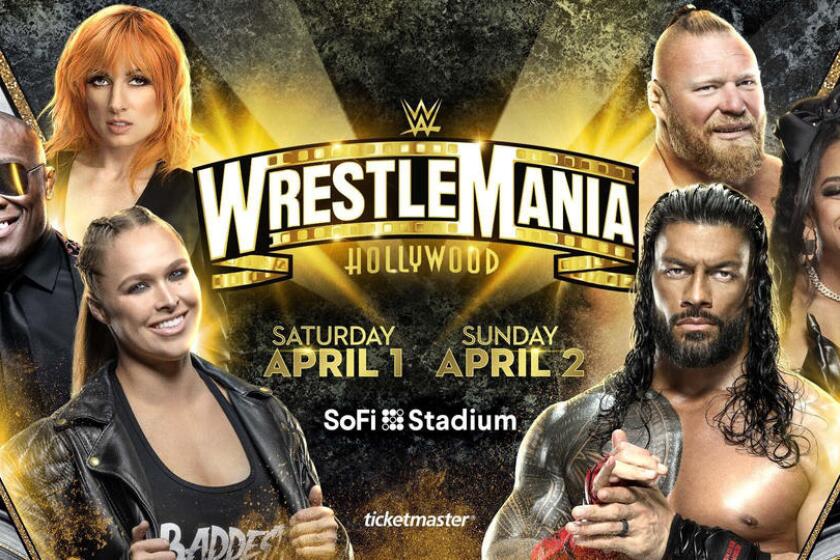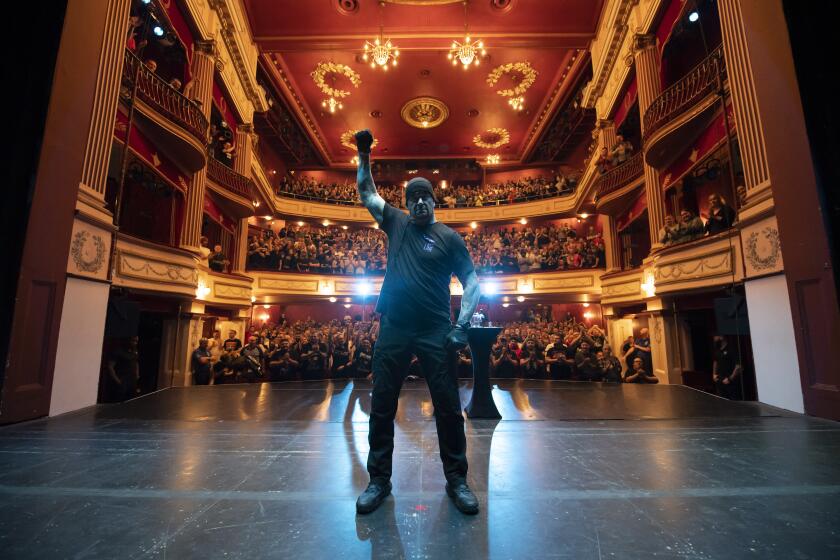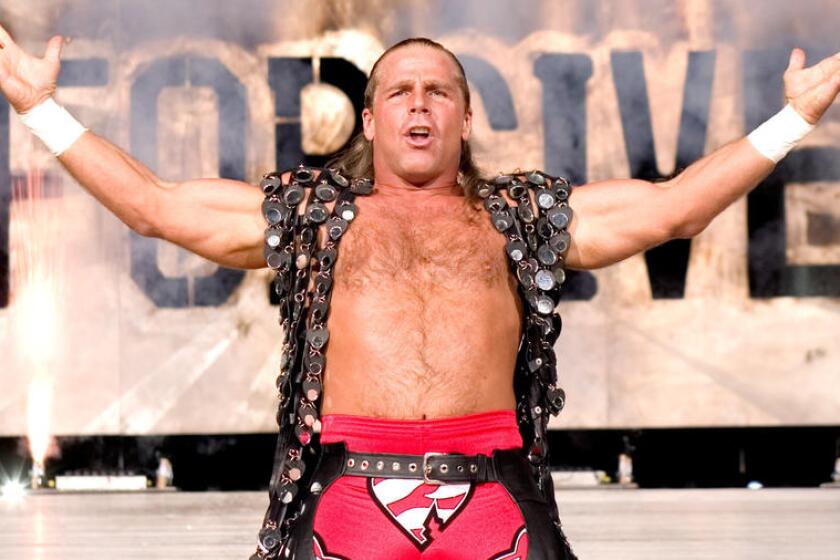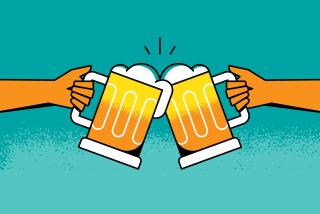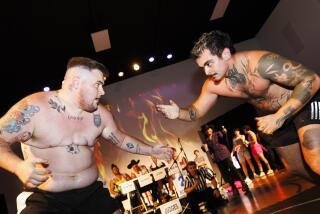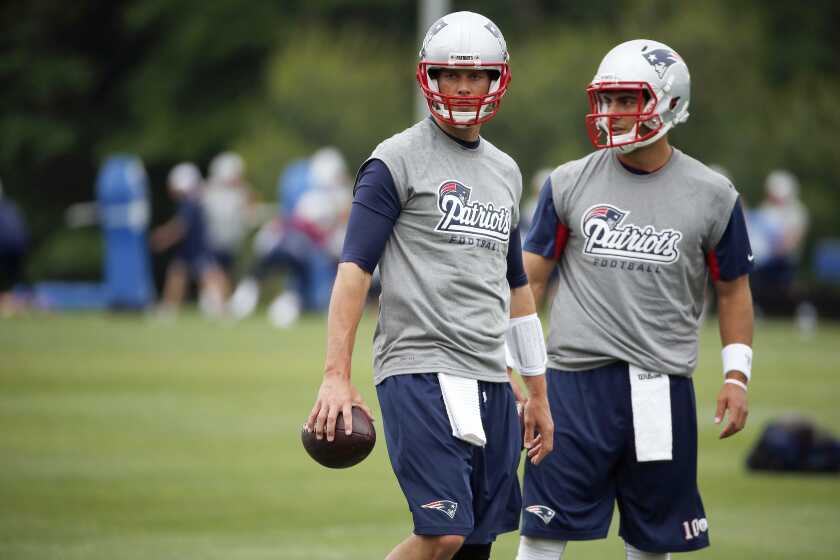Ahead of WrestleMania, here’s a brief history of lucha libre in Los Angeles
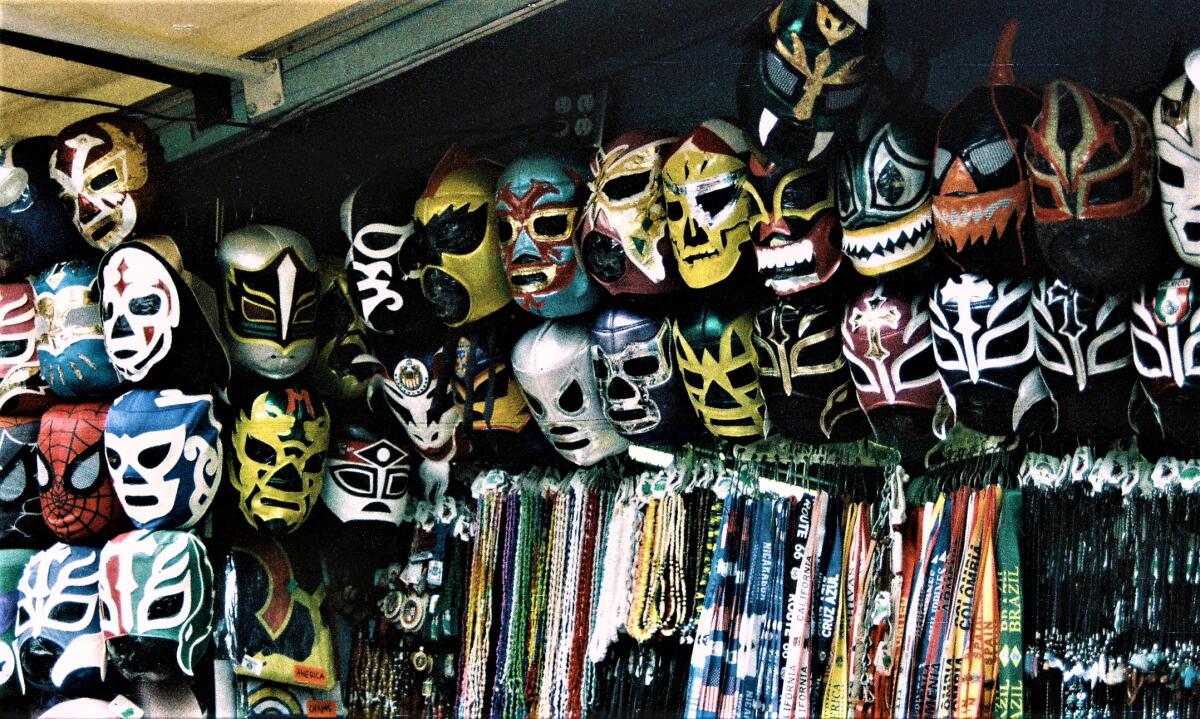
If you want to understand how embedded lucha libre is to Mexican American identity in Los Angeles, all you have to do is take a walk through Olvera Street.
It won’t be long till you see the mask of Santo himself, and next to him — forever paired to the god of Lucha — is his rival, his co-star, his compadre Blue Demon. Their heyday of sellout crowds, and silver screen stardom may be 60 years past, but their legacy lives on in the booths that line the Mexican heart of Los Angeles.
For the record:
11:29 a.m. April 1, 2023An earlier version of this article referred to wrestling promoter Mike LeBell as Mike LaBelle.
Nashbli Rodriguez, a native of Nayarit and South L.A. resident, makes the trip to Olvera Street daily to help run booth C4, A La Mexican Imports, where she sells between 15 and 20 lucha masks a day. She says the most popular masks tend to be outlandish characters like Nacho Libre and L.A. Park — one a comedic take on a luchador, the other a luchador so comedic he’s a meme. Legends like Santo and Blue Demon may last, but they have to endlessly compete with the hottest fictional titans of our times: a Minion, Hello Kitty, and the visages of Marvel characters like Venom, Spider-Man, the Punisher and Black Panther (Namor is not easily turned into a mask, I suppose).
Rey Mysterio, one of the greatest masked wrestlers in history, talks about wrestling his son, Dom, and entering the WWE Hall of Fame.
As Los Angeles grew during the early part of the 20th century, so did its appetite for pastime. Known as the “Madison Square Garden of the West,” the Olympic Auditorium opened its doors in 1925 to vast fanfare and acclaim, just one year after Los Angeles repealed it’s ban on boxing. In 1932, the venue hosted the boxing, wrestling and weightlifting competitions of that year’s Summer Olympics. In the subsequent decades and in addition to championship boxing, the Olympic Auditorium also hosted roller derby and wrestling. Given how bloody these three contact sports can get, it’s no wonder the venue grew to be known by a less flattering yet more apt name, “The Theatre of Violence.”
It was at the Olympic where the early days of lucha libre in Los Angeles took place.
“I was trained by El Gran Goliath and Black Gordman, a pair of wrestlers here in Los Angeles, but they came from Mexico, where they were famous in the 50s and were champions multiple times, ” Jesse Hernandez, lucha libre trainer and owner of School of Hard Knocks, told Times reporter Jad El Reda in 2017.
“I learned from them and now I teach that style of wrestling. They were among the first to wrestle here with Mike LeBell’s promotion, which put on shows at the Grand Olympic Auditorium.”
And it was at the Olympic where the Guerreros built their legend. The family of luchadores from El Paso also served as a catapult to superstardom for Roddy Piper, who took such gusto in antagonizing them that Piper, known for playing the bagpipes before every fight, once offered to play the Mexican National Anthem as a peace offering, only to launch into a rendition of “La Cucaracha.”
A dastardly feat, but one perfectly calculated to incite the crowd against him. Because in LeBell’s NWA Hollywood Wrestling, Mexican luchadores were not the slow-witted villains that they were in wrestling promotions in places like Texas, Tennessee, and Florida. On the contrary, they were the crowd’s favorite stars, a radical choice in the 70s and 80s, but one that clearly understood the historical ties between the Southern California territory and the people who made the city what it was.
One such fan was John Darnielle of The Mountain Goats, who was so taken with the feats of the Guerreros, he dedicated a song to them in “Beat the Champ,” the band’s concept album about the glory days of wrestling in Los Angeles.
At least 38 people incarcerated in a migrant detention center in Ciudad Juárez died in a fire, with dozens more injured.
The Piper-Guerrero feud culminated in 1978 with the “Showdown of the Century,” a bloody loser-leaves-town match where both competitors ended the fight drenched in red, and Guerrero stood triumphant.
But time passes and so does popularity. NWA Hollywood Wrestling eventually folded in 1982 and sold off its territory to Vince McMahon’s World Wrestling Federation (a behemoth now known as World Wrestling Entertainment), turning Los Angeles into an underserved wasteland in the process.
Then came “When Worlds Collide.”
In November 1994, the Asistencia Asesoría y Administración, a burgeoning promotion from Mexico, partnered with Ted Turner’s World Championship Wrestling and sold out the Los Angeles Memorial Sports Arena, filling the dump that jumps with more than 13,000 fans. AAA’s plan was to gain a foothold in America by showcasing its newest stars to a rapt audience.
In the booths at Olvera Street you will also find the mask of Octagón. For “When Worlds Collide,” the AAA hall of famer partnered with Hijo del Santo to take on Los Gringos Locos, a duo composed of the immortal Eddie Guerrero and the inglorious Art “Love Machine” Barr.
Though the Guerreros had been baby faces throughout their careers, Eddie Guerrero was determined to blaze his own path and bucked family tradition by casting himself in the role of a rudo, a bad guy or heel in American wrestling. Here was a cocky newcomer from El Paso jeering at the traditions Octagón and the scion of Mexico’s greatest luchador stood for, all while wearing red, white and blue tights. Their hair vs. mask match showed the promise of what was to come for lucha libre fans in America.
WrestleMania Goes Hollywood is coming to SoFi Stadium in Inglewood on Saturday and Sunday. Here’s our coverage ...
It’s worth pointing out that among the many wrestlers at “When Worlds Collide” was Rey Misterio Jr. The yet unknown 19-year-old luchador from the Tijuana-San Diego borderlands electrified the crowd with his high flying acrobatics.
The show was a success. The aftermath less so.
On December 1994, the peso crisis hit Mexico, gutting the value of what the luchadores were making. This created an opportunity for the WCW, who scooped in and signed the rechristened Rey Mysterio Jr. Within two years, the luchador was opening matches for “WCW Monday Nitro” on TNT as a key part of the fabled “Monday Night Wars” of the late 90s.
By the turn of the millennium, the lucha scene in Los Angeles was on the ropes and the hallowed Olympic was on its way to becoming a church.
“There were three promotions attempting to keep things going right as the Olympic was getting ready to close,” said Will Flores, a 23-year veteran of the Los Angeles lucha scene. He makes up one half of the Los Luchas tag team and wrestles under the ring name “Zokre.”
“[Xtreme Pro Wrestling] was a hardcore deathmatch company who was running shows there. There was a lucha show, and another local guy who was throwing money at shows.”
WWE Hall of Famer The Undertaker will bring his one-man show to L.A. Live the night before Day 1 of WrestleMania.
Flores says the low point came around 2004 or 2005, though he credits companies like Pro Wrestling Guerrilla and Lucha Vavoom for keeping lucha libre alive in Los Angeles during the dark period.
It was they, he says, who paved the way for “Lucha Underground.”
Premiering on Robert Rodriguez’s El Rey Network on Oct. 29, 2014, “Lucha Underground” quickly became a cult hit. The series, filmed in Boyle Heights and downtown L.A., had a blistering four-year run.
A story-driven serial in the vein of Japanese manga, “LU,” as it was known to obsessives, scratched a very specific itch. It gave fans the nostalgia of their childhoods by combining the masked superheroes of Mexico and the drama of “Dragonball Z.”
Goku might not be Mexican, but the heroes of “Lucha Underground” were. And none were bigger than Pentagon Jr., who took center stage in the promotion by entering into a feud with announcer and lucha legend Vampiro.
The show didn’t just bring back lucha libre in Los Angeles in a big way. It also helped reshape the world of professional wrestling.
Mr. WrestleMania says when he knew it was time to retire and takes a tour of many of his WrestleMania matches.
“The fact that lucha has blended in with American style has changed wrestling as it is,” said Flores. “You can now mix the luchadores with the American muscle giants like Hulk Hogan, and Penta proved that at Lucha Underground.”
Lucha Underground was too pure to live. Budget and talent concerns, along with its own success, were its undoing. The luchadores featured on the show became in-demand stars on the American independent scene, and sued for their contract release.
Since leaving “Lucha Underground,” the now Pentagon El Zero M (yes, professional wrestling has IP issues that lead to name changes) has traversed the world. He’s appeared in Japan alongside his brother Rey Fenix, joined the American-owned TNA Wrestling promotion, and eventually found a home in the upstart All Elite Wrestling. The duo now appear regularly on TBS and TNT.

Manuel Quiroz is a well-known mask and gear maker for fighters across the globe, many in L.A.’s popular lucha libre circuit.
In March 2021, the brothers founded Republic of Lucha in South Pasadena. The 4,000-foot retail space has become the beating heart of all things lucha libre in Los Angeles. Monthly screenings of lucha films starring gems like “Santo vs. The Martian Invasion,” “Las Mujeres Panteras,” and the Roddy Piper cult classic “Hell Comes to Frogtown” sell out quickly. Their quarterly live events regularly bring in talent from the U.S., Mexico, and Japan, and are some of the hottest tickets in pro wrestling.
This weekend, WrestleMania, the WWE’s crown jewel event, returns to Los Angeles for the first time since 2005, and the lasting influence of lucha libre is very much apparent.
On Friday night, Rey Mysterio — he dropped the Jr. from his name — was inducted into the WWE Hall of Fame at Crypto.com Arena. An hour before his induction, the living lucha libre legend revived the Latino World Order, a group of renegade luchadores founded by his friend and longtime foe Eddie Guerrero in WCW.
The revitalization of the LWO feels like a full-circle moment for Mysterio, who joined the WWE in 2002 and quickly became a pint-sized star. In 2005, Mysterio competed against Guerrero in the last WrestleMania to occur in Los Angeles. The following year, he won the world heavyweight championship, becoming the first Mexican and only masked luchador to hold a title that traces its lineage to 1948.
On Saturday, Mysterio is scheduled to take on his son Dominik in a long gestating feud that reads as an homage to Guerrero’s “When Worlds Collide” story line.
Outside of WrestleMania, lucha libre is everywhere in Los Angeles this weekend. On Thursday, fans had a chance to relive a match that first occurred at the Olympic in 1994, as Japanese legend Ultimo Dragon took on Negra Casa at the Globe Theatre as part of the WrestleCon Mark Hitchcock Memorial SuperShow. On Friday night the Lucha Bros won the Ring of Honor tag-team championship in a chaotic ladder match at the Galen Center, and on Saturday night Game Changer Wrestling’s The World of Lucha takes place at the Ukrainian Cultural Center and will feature AAA Champion Hijo del Vikingo.
Lucha libre is alive and well in Los Angeles, and this weekend is just another note in the long story of the pastime’s long history with the city, one that’s seen ups and downs, but doesn’t seem to be stopping anytime soon. Just take a walk through Olvera, stop at a booth and pick up a mask. Maybe the mask of Rey Mysterio will make the trip home with you.
More to Read
Go beyond the scoreboard
Get the latest on L.A.'s teams in the daily Sports Report newsletter.
You may occasionally receive promotional content from the Los Angeles Times.
